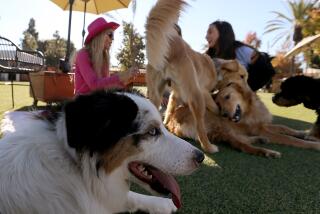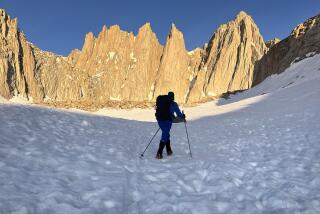Shades of ‘Sgt. Preston of the Yukon’ in Colorado
- Share via
SNOWMASS, Colo. — The kennels were silent when we arrived, but now canine clamor echoes through the valley. Mark, copper-bearded, came running from the source of the noise with a leashed husky dog about the same color as his beard. It wasn’t clear who was pulling whom.
Four 12-foot Arctic sleds, tied down to four stout stakes, stood ready; laid out on the snow in front of each sled was a dog-team harness with 11 yokes. As his dog frisked and pranced, Mark knelt at one harness, clipped the dog’s lead to a ring. He put his hand through a sheepskin-padded yoke, grabbed the dog’s muzzle and pulled its head through. “Down!” he commanded, and the powerful animal settled placidly onto the snow.
Four other dog handlers repeated the process 43 times, until four strings of furry husky dogs lay obediently in their places in the snow. Then the paying customers were parceled out by twos; a handler named Mac invited my son and me to load onto his sled.
Crossing Ski Runs
We were at Krabloonik Kennels, in the same basin as Snowmass Ski Area. Indeed, the trails our dogs would run would cross some of Snowmass’ ski runs.
Long before anyone ever heard of the Iditarod cross-Alaska dog sled race, sled dogs were being bred here in the valley of Castle Creek. These dogs’ ancestors were movie and TV stars, hauling sleds in the “Sergeant Preston” (of the Canadian Mounties) series.
Today, instead of show biz, Krabloonik dogs are loaned to Iditarod competitors and to polar expeditions. Six Krabloonik dogs were on the Seger expedition that reached the North Pole by dog sled last year.
In Aspen-Snowmass, dog sled trips are so popular that at Christmas time, Krabloonik can count on a waiting list of several hundred clients. Out of high season, though, you may be able to get a reservation on a few days’ notice, as we did.
Participatory People
My son Hal and I are both participatory people--we would rather play sports than watch, and drive things than ride--and we feel rather foolish being tucked in like expeditionary baggage. We soon learned that we were in for an adventure, but not in the lap of luxury.
It is advisable to take this trip with someone you already know very well. The passenger system is this: One person sits against the backrest and the second person sits between Person One’s legs, which in turn rest atop Person Two’s legs. Sardines have it roomy by comparison.
Sleds are designed to carry two, but one family in our four-sled party squeezed in three, two adults and a smallish girl. Mac arranged us in the sled, tucking in protruding feet and elbows. He snugged a blanket around our legs and shouted, “Hite!” The dogs rose in unison and begin to pull, kicking snow into our laps.
It crossed my mind, as we were being packed in, that Eskimos never ride in their sleds. Now I know why. At the first steep descent, the sled took a series of bumps that threatened to disconnect my sacroiliac.
My son is taller than I, so it had seemed logical for him to sit behind me so I could see. That was a mistake. The person in back can brace himself by clinging to the sled seat. The person in front has nothing to cling to but the blanket.
The musher has it even tougher. Downhill, he can sometimes stand on the back runner and ride a little, dragging a foot to steer. More often he runs alongside, one hand on the rear of the sled so he can yank it one direction or the other to correct its course. Uphill, he helps push. Sled drivers are very, very lean.
Although the dogs only run every other day, the drivers do two tours a day, six days a week, and care for the dogs in their spare time.
‘Dumbed Out’ Skiers
The trail leveled out, and the ride became more tolerable. After a short stretch of woods, we broke into an open space, the Catwalk run of the ski area. Mac says that sometimes skiers, not expecting to see sled dogs on their run, are “dumbed out” and stand in the way, mesmerized. He runs over their ski tails if they do.
Krabloonik dogs are trained to go at the command, “Hite!” or “Hut!” “We don’t use ‘mush,’ ” Mac said, “because too many smart-aleck skiers yell that at us, and it makes it hard to control the dogs.” He does use “gee” and “haw” for left and right, and “ho,” his voice dropping, for “whoa.”
Our lead dog is named Bugs, but most of the team have Eskimo names: Alooke, Okak, Inook, Queran. The paired dogs are harnessed male-female, in a checkerboard pattern, so they won’t fight.
Harness-mates change every day, to keep the dogs flexible about who their buddies are. “Otherwise, if a dog gets hurt, we couldn’t put in a strange dog,” Mac explained.
The two dogs paired behind the leader are called the point; not every animal will work there, because they don’t have a dog right in front of them. Young dogs work at the rear of the team.
Just before one wide ski trail, a man flagged us down. Mac said, “This first turn is sharp and icy, so we put chains on.” The road we were following didn’t turn that sharply, but the dogs were so fresh and eager that they tried to shortcut it.
Rolling in the Snow
We made it fine, and soon Mac removed the chains. The fourth sled, less lucky, overturned and spilled people onto the downslope--one chain had come off. No one was hurt.
“You haven’t had the full experience unless you’ve rolled it,” Mac commented wryly.
The valley of Snowmass Creek, through which we traveled, is classic Colorado high country: stands of creamy aspen trees, wide meadows rimmed by pyramidal peaks 12,000 feet tall, streams and beaver dams.
Farther up the valley, Krabloonik has a tent, the destination for its all-day trips. Drivers cook lunch there for the guests who, if tired of sitting, can borrow snowshoes and trek two more miles to Snowmass Lake.
In a meadow under a cliff of basalt rock, Mac stopped and allowed us to disembark. The high-altitude sun was strong, we shed parkas for the moment.
Mac said it was a little warm for the dogs. The best working temperature for them is zero to 10 degrees. An 11-dog team can pull about 600 pounds; a 20-dog team, Mac said, hauls more than half a ton.
They’re Very Friendly
I had not approached the dogs because of their reputation for unpredictability, but Mac said it was OK. “For all their wildness, they’re very friendly,” he said. “I’ve only been bitten by a puppy, or trying to break up a fight.” Big babies! They roll over, wiggle, luxuriate in being scratched.
Krabloonik’s dogs are a combination of malamute for large size, Alaskan husky, tough and hardy, and Siberian husky, whose genes produce a short, thick, super-warm undercoat. Mac, unsure of the total numbers, guessed there were 180 dogs in the kennel; it costs $40,000 a year to feed them.
Most working dogs are between 2 and 7 years old. “There’s one that’s 11 and still going strong, but that’s unusual,” Mac said. Older dogs are usually retired to a “puppy team” to train younger dogs.
The dogs are never sold or given away. “They live to pull. They’re too wild and unmanageable if they don’t work,” Mac said.
The return trip was slower; the back-wrenching descent became an uphill requiring frequent stops to rest the dogs. We were headed for lunch, part of the trip package, at Krabloonik Restaurant. Our four sled parties were led to an upstairs room with a wood stove and picture windows framing the peaks. We dined on homemade soups and breads, cold meats, wine and fruit.
Before we finished, the drivers were harnessing teams for the afternoon trip.
For information: Krabloonik Kennels, Snowmass, Colo. 81615; call (303) 923-4342. Half-day trip, $80 per person.
More to Read
Sign up for Essential California
The most important California stories and recommendations in your inbox every morning.
You may occasionally receive promotional content from the Los Angeles Times.













